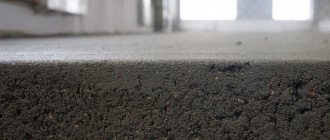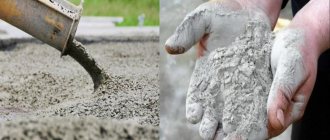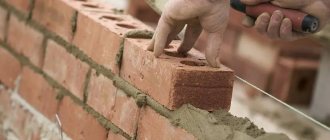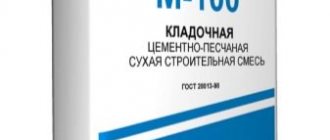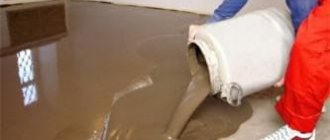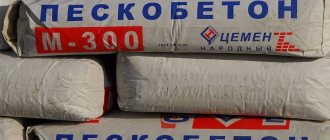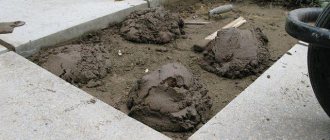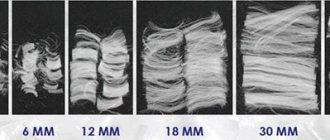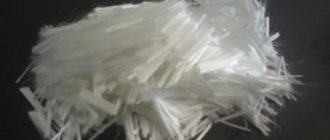The consumption of M150 mixture per 1 m2 of screed is the main parameter that determines the cost of pouring the floor, duration and resource costs. It is very important to be able to correctly calculate the consumption of a cement mixture, because an insufficient volume of solution will lead to technological downtime and deterioration in the quality of the pouring layer due to interruption; exceeding the required volume will lead to unjustified costs (after all, the prepared mixture must be used within 2 hours, then it will be unusable) .
Despite the huge variety of flooring materials on the market, the M150 mixture is considered the most optimal choice due to its reasonable cost, versatility, good technical characteristics, and ease of installation. It is also important that the mixture dries quickly enough and can be used not only for pouring screed, but also for plastering, laying walls made of brick and other blocks, as well as for other work.
Features of mixtures: characteristics, selection recommendations
Dry mix M150, like any other brand, consists of cement and sand.
Letter M
is the brand index, and the number next to it displays the load in kilograms per square centimeter that a completely frozen (within 28 days, as a rule) monolith can withstand. The indicator is approximate, since the strength of concrete is influenced by the quality of the raw materials, compliance with the technology for preparing the solution, correctness of pouring, conditions during the implementation of work and operation, etc.
But under ideal conditions, it is assumed that hardened concrete M150 can withstand a load of 150 kilograms per 1 square centimeter.
Main technical characteristics of cement-sand mixture M150:
- Appearance – dry gray powder of uniform composition.
- Temperature for use in work is from +5 to +30 degrees Celsius.
- Filler size – up to 0.8 millimeters.
- Water consumption per 1 kilogram of mixture is from 0.13 to 0.15 liters.
- Consumption per 1 m2, subject to an application thickness of 10 millimeters - 19 kilograms.
- The density of the hardened monolith is about 1500 kg/m3.
- The permissible thickness of the floor screed layer is up to 4 centimeters.
- Water holding capacity – 90%.
- Setting time – 2 hours.
- Hardening time – 24 hours.
- The full cycle of strength gain is 28 days.
When choosing a mixture of M150 for screed or plaster, masonry, you must carefully read the instructions and take into account the basic requirements for operation: expected loads, exposure to negative factors, the need for frost resistance and resistance to chemical factors, etc.
When calculating the mixture consumption, it is advisable to take into account that the specified standards on the packaging are aimed at experienced craftsmen and the most accurate adherence to technology. Actual consumption is usually 12% more.
The main competitive advantages of cement-sand mortar M150: economical consumption, versatility in use, high quality of all components (taken in the correct proportions), reliability and strength, good level of frost/water resistance, full compliance with GOST standards and requirements. The mixture is made on the basis of high-quality Portland cement of various brands, with the addition of clean sand, various impurities, and polymer additives.
A mortar based on dry mix M150 can be used for the following work: concrete floor screed, interior/exterior finishing, plastering, leveling ceilings, laying bricks, gas blocks and other types of building materials. Concrete is well suited as a base for subsequent wallpapering, painting, and puttying.
Cement-sand mortar is also used for cementing stairs, repairing and eliminating cracks in floors and walls, and restoring areas with damaged plaster. The solution can be used to level the ceiling without the use of reinforcing mesh, provided the layer is no more than 3 centimeters thick.
Application area
Let's look at where M150 concrete is used. Usually, when it comes to concrete solutions, they can be used for almost any type of construction work in the private sector. However, the technical characteristics of a particular composition limit the permissible types of installation activities. For example, due to the low weight of a cubic meter of M150 concrete, and therefore low density, it cannot be used for the construction of critical, loaded structures.
If we talk about the foundation, then the composition can be used in two cases. This can be an independent reinforced base for an extension, gazebo or shed. In the case of residential buildings, only the installation of a layer between the soil and the foundation is permissible. The same applies to the road surface or storage area for vehicles.
Source pkdom.ru
As a rule, the scope of application of M150 concrete extends to the interior decoration of the building. This could be leveling screed, plastering walls, erecting partitions. Of course, the composition does not always contain gravel or crushed stone. In the yard, the solution is useful when concreting pillars, decorating paths with curbs, laying paving slabs or artificial stone.
In this video, the master explains and demonstrates how to properly mix concrete mortar in a concrete mixer:
Types of mixtures
The variety of cement and sand-based mortars on the market is large, but the most popular are the brands from M100 to M300, which are most often chosen for certain work due to their versatility, low cost, and ease of use.
M100
A solution of cement-sand mixture M100 includes, in addition to the main components, lime in the composition. Therefore, the price of the dry mixture is slightly lower than analogues of a higher brand. A solution prepared on the basis of dry mixture M100 is suitable for eliminating minor defects in previously poured screeds, for leveling the base, plastering walls and ceilings.
M200
This composition is called masonry assembly. The material is presented on the market in several modifications, which are selected in accordance with the purpose of the mortar: for plastering, pouring screeds, masonry. Given a thickness of 5 millimeters, the consumption of the M200 dry mixture is about 8.5 kilograms per 1 m2.
M300
This cement-sand mixture is called foundation, since it is usually used when pouring prefabricated, strip or monolithic slab foundations. The cost of the material is quite high compared to other brands. The solution is also used in arranging screeds and laying block structures. About 19.5 kilograms of mixture are used per square meter.
M150
This composition is considered universal, since it is suitable for almost all types of work: laying walls from blocks, plastering various surfaces, pouring monolithic structures, manufacturing products, repairing and restoring collapsed concrete monoliths, etc. In addition, if necessary, the M150 mixture can replace any other.
The finished cement-sand mortar may already contain various additives or involve the introduction of plasticizers and additives into the mixture at the time of its preparation. The final composition of the components is selected based on the tasks and conditions of the work and the further operation of the concrete.
The main areas of application of the composition: internal/external finishing work, pouring foundations and floors, ceilings and plinths, finishing facades and laying walls, carrying out work in rooms with high levels of humidity and various aggressive influences.
To prepare the dry mixture, just add water according to the instructions and mix thoroughly. If necessary, you can make the solution yourself by taking the necessary materials in certain proportions.
Mistakes made when operating the DSP
Much has been said about the advantages of mixtures used for various procedures. However, whether you can achieve the appropriate result depends on the correct use of the DSP. Avoid common mistakes:
- exclude long-term storage of building materials, because every month its quality characteristics deteriorate;
- select the mixture correctly, determining the optimal brand (insufficient power can provoke rapid destruction of the created object);
- unconditionally comply with GOST requirements, for example, add anti-frost additives when pouring foundations in a cold region;
- prepare the floor plane and finish it so as not to cause the coating to quickly deform due to incompleteness of the support or incorrect sequence of laying the selected mixture;
- follow guidelines for maintaining the percentage of each ingredient in the mixture.
As for the building materials themselves, we, like any reputable seller who values their customers, have implemented a system of quality indicators. The entire range is suitable for the creation and restoration of any buildings and structures.
Optimal consumption M150
If we consider the M150 brand mixture, then the consumption per 1 square centimeter of floor screed is 22 kilograms, provided that the fill layer is 1 centimeter thick. The thickness of the layer can be any, but usually no more than 5-10 centimeters. The viability of a solution mixed with water is 2 hours, so the mixture is made in portions and poured manually. The monolith gains a full cycle of strength after 28 days.
The floor is strong and reliable, capable of withstanding considerable loads: bending strength is 2 MPa, adhesion – 0.5 MPa. To increase adhesion with further coating, the concrete floor is properly prepared (coated with various primers, impregnations, mechanically processed, etc.).
Purchasing from AlfaCem
We hope that thanks to our advice you will be able to effectively use the purchased building materials. Do not forget that for the effective operation of dry mounting mixtures, you need to order primers, facing coatings and other products, including tools.
Leave a request on the website (you can register and log in for the convenience of ongoing cooperation) or call us directly. You can discuss any products with competent and responsible managers. They will help you order and receive popular products included in the product catalog. Representatives of the company will tell you about the rules by which payment and delivery are carried out. We serve not only the Moscow region, but also the entire Central Federal District of the Russian Federation.
Each client will receive a quality product by ordering the required volume. At the same time, we take care of full compliance with warranty obligations. The final price for the delivery set can be reduced due to ongoing promotions and introduced discounts. Waiting for you!
Self-preparation of the solution
The dry mixture M150 is sold in a ready-made version - you just need to mix it with water according to the instructions. But you can make the mixture yourself by mixing all the required components. The proportions of cement, sand, coarse filler can be different and depend on the purpose of the mixture, the brand of cement used, and the conditions of the work.
It must be remembered that long-term storage of cement or short-term storage in unsuitable conditions can cause poor quality of the solution. It is better to store cement for no more than 3 months on special wooden stands in closed factory containers, in conditions of low humidity and protection from precipitation. But it is best to buy cement immediately before starting work.
To fill the floor screed, take cement grades M400 and M500 in the following proportions: part cement, two parts sand (for M400) or three parts sand (for M500). To strengthen the floor and eliminate the possibility of deformation, you can add fiber fiber directly to the solution: 900 grams per cubic meter of solution.
The following recipe is suitable for masonry:
part cement and four to five parts sand (here the choice depends on the condition and quality of the sand - whether it is washed, dried, free of impurities, etc.). The solution is mixed in small portions so that it can be worked out within a maximum of two hours.
For plaster, a solution prepared from cement grades M200, M300 in the proportion of one part cement and three parts clean sifted sand is suitable.
It is advisable to mix all the ingredients using a special attachment on a drill. The proportions should not be changed - in attempts to save money, sometimes the proportion of cement is reduced, which leads to the spread of cracks, deformations, decreased strength, increased hardening time and other problems.
